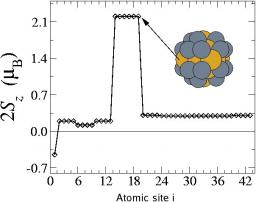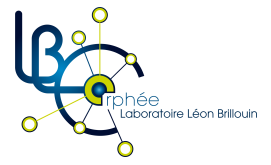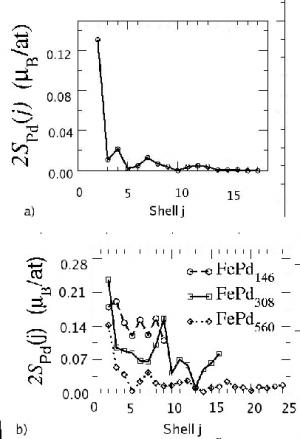Laboratoire Léon Brillouin
UMR12 CEA-CNRS, Bât. 563 CEA Saclay
91191 Gif sur Yvette Cedex, France
+33-169085241 llb-sec@cea.fr
Magnetic properties of bimetallic transition metal clusters



Calculated local spin moments of the Fe19Ni24 cluster for a core shell structure with a Fe core (sites 1-19, Fe atoms, 19-43 Ni atoms)
Small aggregates possess many specific behaviors absent in the bulk phase. Among them their magnetic properties are considered to have the most important application field, in particular for magnetic recording materials since the recording density, the recording speed, the noise suppression and the life time are remarkably enhanced as the magnetic particle size decreases. In this context bimetallic particles are very interesting since, besides pure size effects, their properties depend on their composition and on the type of chemical order present in the particles.
FeNi alloys are widely used magnetic materials. Surprisingly experiments have shown that the magnetic moment per atom in FeNi clusters is much lower than that of the bulk alloy of the same composition [1]. Using a Stoner-like tight-binding model, including spin-orbit coupling, we have calculated the magnetic properties of fcc FexNi1-x clusters (x<0.6) containing up to about 300 atoms for several compositions and three types of chemical order: random and core-shell structures with either Ni or Fe cores [2]. The results show that only the latter type of order is compatible with the observed reduction of moment which can be explained by the existence of an anti-ferromagnetic order in the fcc Fe core (Fig.1)
FeNi alloys are widely used magnetic materials. Surprisingly experiments have shown that the magnetic moment per atom in FeNi clusters is much lower than that of the bulk alloy of the same composition [1]. Using a Stoner-like tight-binding model, including spin-orbit coupling, we have calculated the magnetic properties of fcc FexNi1-x clusters (x<0.6) containing up to about 300 atoms for several compositions and three types of chemical order: random and core-shell structures with either Ni or Fe cores [2]. The results show that only the latter type of order is compatible with the observed reduction of moment which can be explained by the existence of an anti-ferromagnetic order in the fcc Fe core (Fig.1)
It is well known that Fe impurities in Pd induce a magnetic polarization of the neighboring Pd atoms leading to the formation of giant magnetic moments (about 6-7 μB) per Fe atom in the dilute limit, the polarization cloud extending over about 300 atoms (i.e., about 15 coordination shells). It is thus interesting to investigate how the polarization cloud is modified by size effects in small aggregates [3]. We have first considered the case of a single Fe impurity in PdN clusters. The results show that when the Fe atom is placed at the center of the cubo-octahedral clusters the polarization cloud becomes very similar to the bulk one only when N≥561. For smaller sizes the total moment is strongly enhanced (~12 μB if N=147, ~28 μB if N=309) (Fig.2 a,b)
However, according to our calculations, the most stable position of the Fe atom is in the subsurface region in the vicinity of the cluster apices. In that case the absence of symmetry induces a very complex distribution of moments. This distribution becomes more and more complex when several impurities are present in the cluster due to the strong interference effects between their respective polarization clouds.
However, according to our calculations, the most stable position of the Fe atom is in the subsurface region in the vicinity of the cluster apices. In that case the absence of symmetry induces a very complex distribution of moments. This distribution becomes more and more complex when several impurities are present in the cluster due to the strong interference effects between their respective polarization clouds.
REFERENCES
[1] X.G. Li, A.Chiba, S. Takahashi, J. Magn. Magn. Mater. 170, 339 (1997)
[2] R.Guirado-Lopez, M.C. Desjonquères, D. Spanjaard. Eur. Phys. J.D 36 , 67 (2005)
[3] R.Guirado-Lopez, M.C. Desjonquères, D. Spanjaard, Phys.Rev.B 74 064415 (2006).
[1] X.G. Li, A.Chiba, S. Takahashi, J. Magn. Magn. Mater. 170, 339 (1997)
[2] R.Guirado-Lopez, M.C. Desjonquères, D. Spanjaard. Eur. Phys. J.D 36 , 67 (2005)
[3] R.Guirado-Lopez, M.C. Desjonquères, D. Spanjaard, Phys.Rev.B 74 064415 (2006).
#786 - Last update : 10/07 2009
•  Future optics and electronics › Nanomagnetism, spintronic and multiferroic materials
Future optics and electronics › Nanomagnetism, spintronic and multiferroic materials
• Service de Physique et Chimie des Surfaces et des Interfaces • Laboratory of Physics and Chemistry of Surfaces and Interfaces
• GMT-MSIN : Modélisation des Surfaces Interfaces et Nanostructures • Laboratory of Nano-Objects and Complex Systems (LNOSC)




